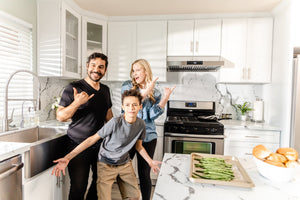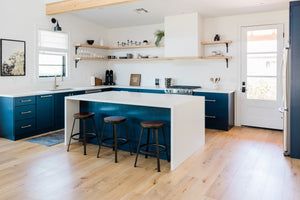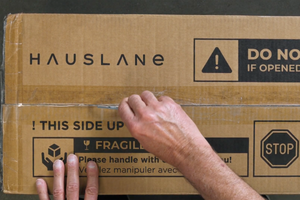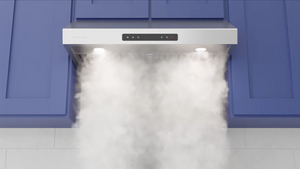How to Clean Greasy Kitchen Walls: DIY and Non-Toxic Methods
Cleaning walls? That’s one activity that’s not at the top of fun weekend activities. However, giving your walls a good scrub goes a long way to making your house look and smell fresh. It’s especially important to regularly wipe down your kitchen walls as grease can pile up and cause lingering odors. In this guide, we’re sharing our top tips for getting your walls in tip-top shape. You’ll find handy DIY methods with non-toxic ingredients to make this household chore a breeze!
How to Safely Clean:

General Tips:
- Always begin with the most gentle cleaning option and progress to stronger solutions if needed.
- Always perform a patch test in an inconspicuous spot, regardless of cleaning method or material.
- Frequent light cleaning can prevent the need for more aggressive and time-consuming deep cleaning.
- Use your range hood every time you cook to snag grease before it has a chance to drip down on your cabinet, walls, countertops, and food.
Painted Walls

DIY Method:
Mix a solution of 1/2 cup white vinegar, 1/4 cup baking soda, and 1 gallon of warm water. This combination is gentle enough not to damage the paint but effective against grease. Using a sponge or a soft cloth, gently scrub the walls. Rinse with clean water and pat dry.
Non-toxic Commercial Cleaner:
Look for non-toxic, biodegradable degreasers. Before using any commercial cleaner, do a patch test in an inconspicuous spot to ensure it doesn’t affect the paint.
Tile Walls

DIY Method:
Create a paste using baking soda and water. Apply the paste to the tiles and grout lines, and let it sit for 10 minutes. Scrub with a brush or cloth, paying extra attention to grout lines, as they can trap more grease. Rinse with water.
Non-toxic Commercial Cleaner:
An all-purpose non-toxic kitchen cleaner will usually work on tiles. Opt for one that mentions degreasing capabilities.
Wooden Walls

DIY Method:
Mix a solution of 2 cups of warm water, 2 tbsp white vinegar, and 2 tbsp olive oil. The vinegar helps cut through the grease, while the olive oil acts as a natural polish for the wood. Dip a cloth into the solution and wring it out so it's damp, not wet. Wipe the wooden walls in the direction of the grain.
Non-toxic Commercial Cleaner:
Ensure the cleaner is specifically designed for wooden surfaces. A non-toxic wood cleaner will both clean and nourish the wood without causing any damage.
Stainless Steel Backsplash

DIY Method:
A mixture of 1 part white vinegar to 2 parts water is an effective cleaner for stainless steel. Spray it on the backsplash, let it sit for a couple of minutes, and then wipe away using a microfiber cloth in the direction of the steel grain.
Non-toxic Commercial Cleaner:
There are numerous stainless steel cleaners available in the market. Ensure it's non-toxic and free from harmful chemicals, especially if you're using it near food prep areas.
Wallpaper Walls
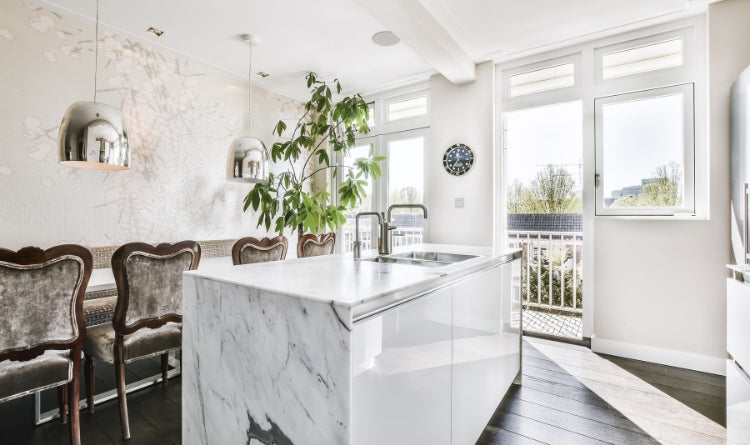
DIY Method:
Because wallpaper can be delicate, especially if it’s not the washable kind, start with a light touch. Dab a soft cloth in cornstarch water (a mixture of cornstarch and cold water), and gently blot the greasy spots. If the wallpaper is washable, you can follow up with the DIY painted wall cleaning method, but ensure you don’t over-saturate the paper.
Non-toxic Commercial Cleaner:
Only use cleaners explicitly labeled safe for wallpaper. Always test a small, inconspicuous area first.




